Shingu's main attractions
The Ruins of Shingu castle (Tankaku)
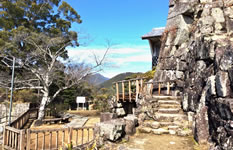
Located on the Northern side of the city, the ruins rise against the Shingu river. Beyond the river mouth in the East, they overlook the Pacific Ocean. The castle is called Okimi castle (open sea view castle).
It is now maintained as a park, and if you climb the remaining stone ruins, the view is really mesmerizing. (8-min walk from Shingu station)
Kumano Hayatama Taisha
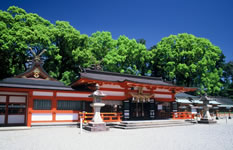
With the Hongu Taisha and Nachi Taisha, it is one of the three Kumano Sanzan shrines. Once believed to be the incarnation of Kumano Gongen, it represents the biggest local religious kingdom.
The god, deified by the Kamikura-san, was moved to the actual shrine, and since then, what was once called Kamikura-san was renamed Shingu. The actual shrine was rebuilt after a fire burnt it down in September 1883. (15-min walk from Shingu station)
Mifune rowing
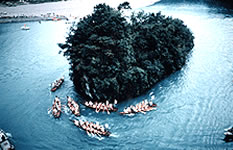
The Mifune Festival, as the Kumano Hayatama Taisha Festival, is well worth viewing. The festival is boat races of beautiful Shinkosen (boat) and other nine boats,(16th October).
It has been designated as an Intangible Folk Cultural Property by the prefecture since May 1964.
Miwasaki Kujira Odori (Whale Dance)
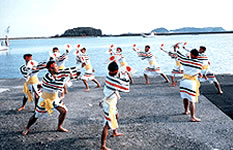
Miwasaki is a fishing port in the city of Shingu facing the Kumano-nada sea, and it is where the so-called whale dance, also named "whaling dance", was conceived as a dance to catch whales. Story tells that the kujira odori was established around 300 years ago when the local lord of the family Mizuno offered whale meat to nobles who came from Kyoto.
Since then, it has been performed during the annually held Miwasaki Hachiman Shrine Festival as a prayer to the big whale.
It has been designated as an intangible asset of folk culture by the city since January 1967, and since December 1974 as an Intangible Folk Cultural Property by the prefecture, and has been kept alive by the Miwasaki Entertainments Preservation Association.
Oto Fire Festival
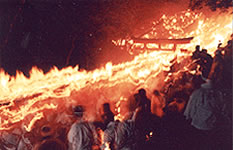
The Oto Fire Festival is one of the regular festivals held at the Kamikura Shrine and one of a long tradition among Kumano Shingu's. It is a lively festival where torches are carried down the stone steps of the shrine. (6th Feb.)
It has been designated as an Intangible Folk Cultural Property by the prefecture since May 1964.
From the windows of our hotel it is possible to enjoy a spectacular view of the torches that look like a flying dragon.
Jofuku Park
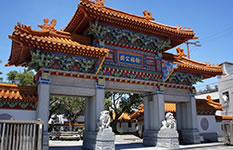
The park is located at 100 m from Shingu station, with its exceptional Chinese style tower gate. The precinct is surrounded by huge camphor trees and evergreen lindera trees, and was erected around Jufuku's gravestone. Next to Jofuku's grave was erected a monument of the seven disciples that, legend says, immolated themselves at the time of his death. It is also possible to buy products that are related to Jofuku like "Jofuku tea" and "Jofuku roman" at the administration building. (2-min walk from Shingu station)
Sato Haruo Memorial Museum
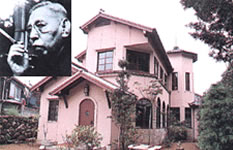
Born in Shingu Funamachi on April 9, 1892 to a doctor, Haruo Sato is the best known writer from Kumano, and through nostalgia lived his entire life composing poems.
His romantic and aesthetic works are melancholic and intense in a modern way, dividing the literary world, and he was considered a great poet.
Haruo Sato Memorial Museum was relocated from Tokyo, and the inside building was reconstructed in order to hand down his works to posterity. Many personal items, like Sato’s manuscripts and everyday utensils, are on display. (15-min walk from Shingu station)
Activities and Festival Calendar in Shingu and nearby areas
- February 6
- Oto Fire Festival ( Shingu - Kamikura Jinja Shrine)
- April-November
- Kumano river canoeing (Kumanogawa town)
- May-September
- Logging Rafts Tour at Kitayama River (Kitayama village)
- July 1
- Sea-side resort (Nachi beach)
- July 14
- Ogitate Matsuri (Shingu, Kumano Hatayama Shrine)
- July 14
- Nachi Himatsuri (Kumano Nachi Shrine)
- August 17
- Kumano Fireworks Festival (Kumano - Shichirimihama)
- August 12-13
- Kumano Jofuku Mando Festival
- September 15
- Miwasaki Hachiman Shrine annual festival , "Miwasaki Kujira Odori (Whale Dance) (Shingu - Miwasaki Hachiman Shrine)
- October 14-15
- Shingu Shoko-sai Festival (Shingu)
- October 15-16
- Kumano Hayatama Taisha Annual Festivals (Shingu, Kumano Hayatama Taisha) (Shinme Togyo Ceremony, Mikoshi Togyo Ceremony, Mifune Festival)
- November- end of February
- Sennin Buro (onsen river) opening time (Kawayu Onsen in Hongu)

